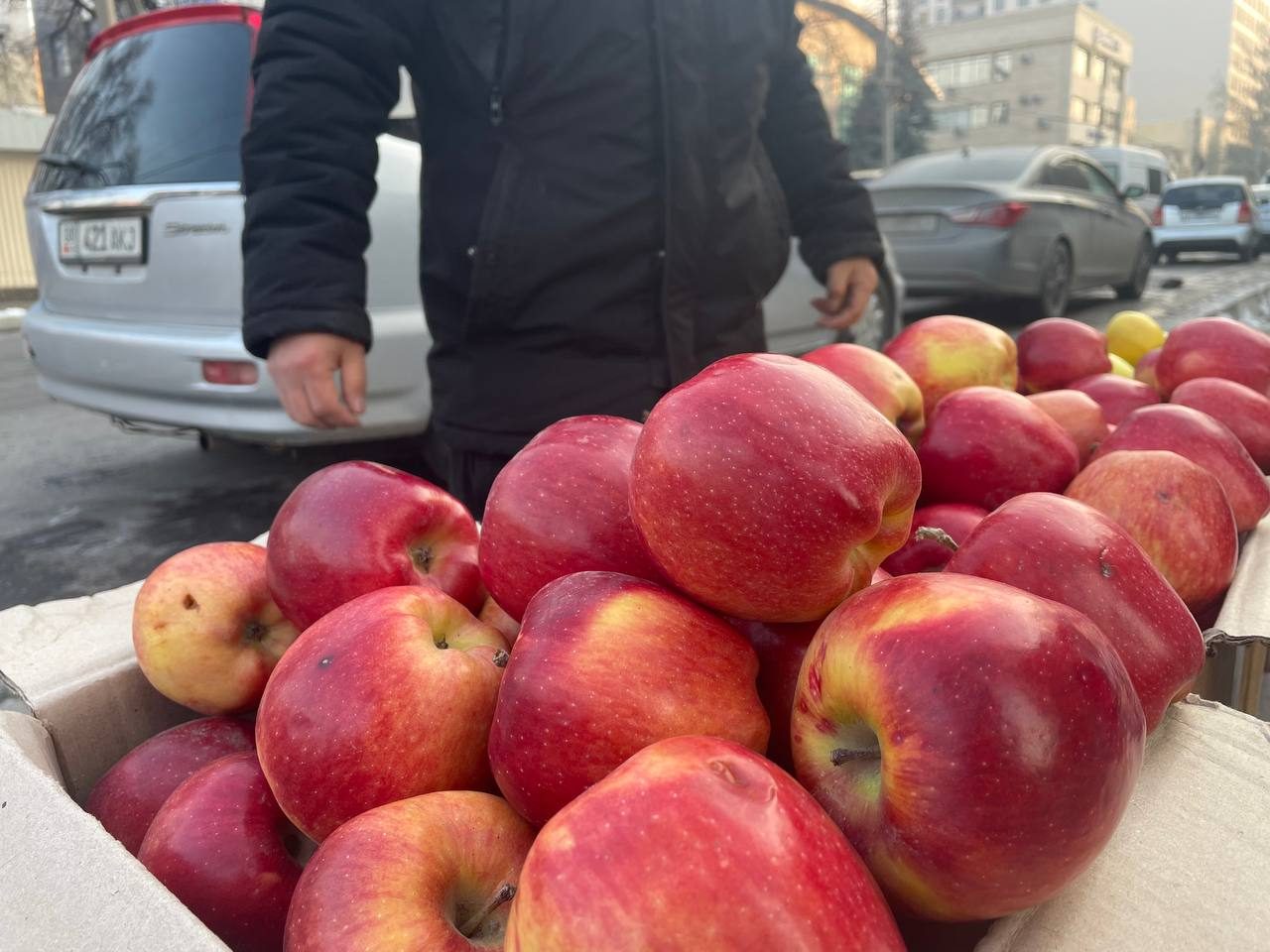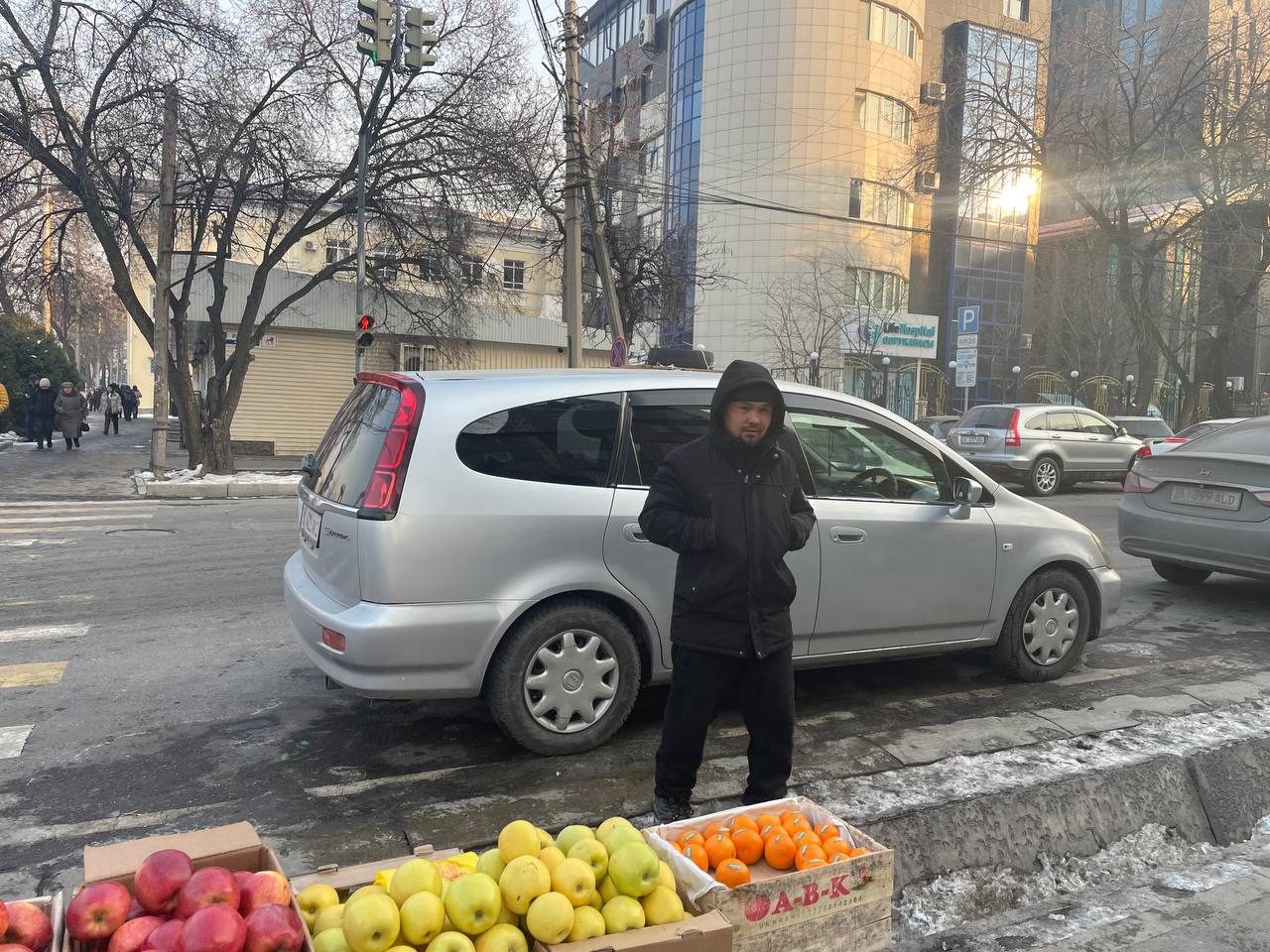In recent years, the capital of Kyrgyzstan has been on the top of global air pollution rankings every winter. Despite numerous promises by the authorities and working groups against smog, the city still suffocates, and the number of people having respiratory diseases is increasing.
Breathe, don’t breathe
Aman Akbarov cleans his produce – apples from Issyk-Kul – once in 10 minutes. He said that no one would buy fruit dirty from dust. He sells them in the centre of Bishkek, along the roadway.
“If it’s very cold, I leave earlier – at 6 or 7 pm. It is quite a breathable atmosphere here in the afternoon, but in the evening, when there are many cars, I cover my nose with the scarf. This is the way when breathing is easier. I’ve noticed that at the end of the day my throat gets itchy. When I come home, I can feel that my nose is filled either with some dirt, or with some black dust. I don’t wear the mask because I feel uncomfortable in it. I don’t think it protects me anyway,” he said.
Photo: CABAR.asia
This winter, the capital of Kyrgyzstan has regularly led global air quality rankings. In average, the sensor data as of December 2022 and January 2023 were above 200 IQA, which is a hazardous indicator.

This is what Bishkek looked like on December 12, 2022. That day, according to the air quality control website, the level of pollution reached 430 AQI in certain areas, and was ranked as very unhealthy. According to health workers, polluted air enters the body not only through the mouth or nose, but also through eyes and skin. The acrid smoke enters blood and then hazardous particles distribute along all organs and do most harm to the heart function.
According to the National Statistical Committee of Kyrgyzstan, in the last 10 years the number of people who have asthma, bronchitis, pneumonia or tuberculosis has increased approximately by 100 thousand. The surge took place in 2016, when there were 60 thousand patients more registered than that in the previous year. In 2020, there was a sharp decline.
Chief pulmonologist of Kyrgyzstan, Talant Sooronbaev, said that the incidence rate is related not only to poor air quality. According to him, the influencing factors are stress, level and quality of living. However, according to his observations, most patients with respiratory diseases come from large cities of Kyrgyzstan – Bishkek, Osh and Dzhalal-Abad.
“As we all know, cities produce large amount of motor vehicle exhaust. As a matter of fact, there is no fresh air to breathe in winter in Bishkek. There have been no scientific research so far, and we cannot say why there was such an increase. All we can do is make assumptions,” Sooronbaev said.
A sharp decrease in the number of patients with respiratory diseases in 2020 is associated by health workers with the pandemic, when Kyrgyzstanis were under the lockdown.
“We contacted less with other people. And respiratory diseases are usually transmitted by air. Besides, people cared about their health so much, they wore masks, used hand sanitizers. That’s why there were fewer infections,” said Aizharkyn Egemberdieva, epidemiologist of the Republican Centre for Health Promotion and Mass Communication.
However, hospitals and policlinics overcrowded with coronavirus patients could have impact on the statistical data, and, consequently, on the availability of medical care to other patients.
Why is there smog in Bishkek?
According to ecologists, there are four reasons of smog over Bishkek.
Private sector. There are 47 new neighbourhoods around Bishkek. Their residents usually heat their houses with low-calorie coal. It burns slower yet produces more smoke. However, coal is a luxury thing to have for many residents of those residential areas. Instead, they use textile waste and rubber, as they are free of charge.
Old vehicles. According to official data, the capital has nearly 1 million vehicles. Most of them past their expiration dates and are considered a waste, said Maria Kolesnikova, chair of the ecological organisation “MoveGreen”. 80 per cent of vehicles in the capital do not have catalytic converters.
“Catalytic converters filter out soot and smut in exhaust gases. But they cost a lot in the market and vehicle owners resell them. No authority in Bishkek checks whether vehicles have catalytic converters installed,” Kolesnikova said.
A wind rose. Because of the chaotic construction, Bishkek does not have enough wind and therefore the polluted air literally hangs over the city.
HPP of Bishkek. This is a controversial reason. According to HPP representatives, the latest study by Finnish researchers found out that emissions of the heating power plant have impact on smog only in 1 per cent. Ecologists suggest that there is more impact because the HPP of Bishkek uses fuel oil and low-calorie coal.
Gasification – a way out of the situation?
According to the government of Kyrgyzstan, shifting to gas heating, as well as coal upgrading and briquetting will help tackle smog in Bishkek. Speaking at the faction meeting of parliament on February 7, Dinara Kutmanova, minister of natural resources, ecology and engineering supervision of Kyrgyzstan, said that hazardous emissions could be reduced twofold by increasing heating value of fuel.
Ministry of Natural Resources asked the UN for a 6.7-million-dollar grant from donors as the agency plans to introduce alternative sources of energy such as heat pumps, solar panels in single-family homes.
Another initiative by the cabinet of ministers is to introduce partial limits for road traffic in Bishkek. This idea was voiced by Akylbek Zhaparov, head of the cabinet of ministers, at the end of January. He demanded that the town council develop the odd-even scheme so that vehicles with registration numbers ending with odd and even digits would be allowed on roads on odd and even dates, respectively.

Specialists take these plans of the government with a pinch of salt. According to Maria Kolesnikova, neither coal upgrading, nor gas heating, which is not affordable by most residents of new neighbourhoods, will not resolve the problem of smog.
Instead, experts suggest that the state pay attention to insulation. According to Ilgiz Kambarov, executive director of public foundation “Green Alliance of Kyrgyzstan”, up to 70 per cent of heat in single-family homes penetrates uninsulated walls, windows, floor and doors. He suggested that the authorities allocate subsidies for this purpose. According to estimates of specialists, the state would allocate nearly 500 million dollars on it. And there would be no need in the huge grant from the UN then, Kambarov said.
According to him, once first air quality sensors appeared in Kyrgyzstan in 2017, smog is the number one news in the country every winter. But nothing has changed in five years and the city keeps on suffocating.
According to deputy chair of the Union of Architects Belek Sarymsakov, tackling smog does not need much of investment. It only needs a good general plan of the capital and no chaotic construction.
“The mayor’s office needs to take a close look at the 2006 general plan. It is quite competent but implemented only by 15-20 per cent. Alamedin and Ala-Archa floodplains, south of the Big Chui Canal are being developed. But initially they served as a flow path, which took cold air from mountains to the city. And now those buildings hinder ventilation,” Sarymsakov said.
He said that the 2006 general plan was developed to give priority to pedestrians rather than vehicles. And the continuous expansion of roads and extraction of trees do not contribute to improved air quality.
Ecologist Andrei Podrezov said that there are other extra measures to help Bishkek cope with smog:
- Smoke filters must be installed on boiler house pipes;
- The old spoil disposal must be closed;
- All waste, including kitchen waste, must be recycled;
- Pedestrian and cycling infrastructure must be developed instead of motor roads;
- Separate lanes must be provided for public transportation;
- Green areas should be prevented from development.
What about others?
One of successful examples of air pollution control is Ulan-Ude, the capital of Mongolia. The authorities began to actively tackle polluted air since 2016.
The main reason of smog in Ulan Bator were single-family homes around the capital. They heated their homes with traditional iron furnaces, and used the cheapest fuel – raw coal. It was not treated and emitted fine particulates in big volumes upon combustion.
After all studies, the authorities imposed heavy fines on its use, and provided the residents with coal briquettes instead of low quality coal, and replaced old furnaces with energy-efficient ones. For that, the authorities subsidised purchases of furnaces. Moreover, power supply became free of charge at night, and people started to heat their houses with heaters at night. All these measures helped reduce emissions two-fold.
European cities tackle smog by means of high fines or taxes. For example, the authorities of London came up with the congestion charge for drivers living outside of the city and driving into it for work or for business. Those car owners, whose cars do not meet modern emission requirements, have to pay 10 pounds per day for driving in the centre of London.
The authorities of Madrid started tackling air pollution at the end of 2016. When the air quality gets worse in the city, the municipal government introduces temporary restrictions for drivers – they are prohibited from driving into the city. The same is done in Italy.
- If you have a car, you should use it only if strongly required. Instead, you should take a trolleybus, or electric scooter or bicycle in warm weather to get to work/study.
- Do not heat your house with textile waste, car tiers.
- If possible, install a smoke pipe over the house as high as possible. Or, it’s even better to shift to gas heating.
- Do not incinerate leaves or garbage.
- Wear respiratory masks N95.
- Do not ventilate your house in the evenings.
- Smog is the most hazardous in late hours in Bishkek, when most residents return home and start heating single-family houses.
- Wet clean often. Buy an air purifier for home or office if you can afford it.
- Every time you return home from outside, wash your nose, or better take a shower as harmful particles build up on hair and skin.
- Drink more water, eat fruit and fresh vegetables. Strong immune system will help get rid of smog particles that have penetrated the body.



